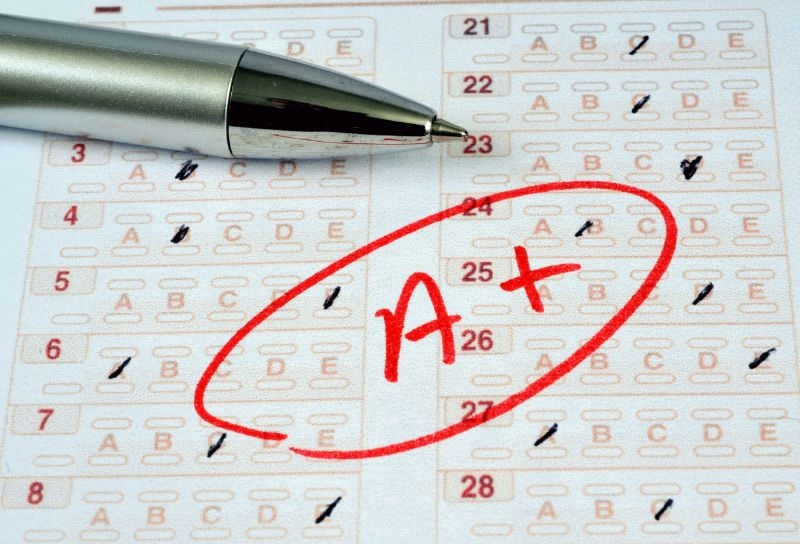
How I Grade My Biology Students
Grading biology students can be hard. We have to look at not only how well students understand basic ideas and principles, but also how well they can apply these ideas to real-world situations.
As a biology teacher, it’s important to develop a grading system that is fair, consistent, and accurately reflects each student’s performance.
In my classroom, I grade my students in a variety of ways. I want to share them with you today:
- Constructive Feedback through Formative Assessments
- Laboratory Activities
- Summative Assessments
Let’s go through each one!

Constructive feedback
We, as teachers, all know that the grade is not the most important aspect of a class.
It’s the students that need convincing and to understand that everything may not be for points or a grade. Before the final test, students can use formative assessments to find out what they are doing well. They’ll also see what they need to work on.
Instead of always assigning a grade, I will provide comments that help students identify their strengths and weaknesses.
Furthermore, I will help students understand how to improve their weaknesses and determine effective study strategies.
While this type of grading benefits all students, it can particularly help students with extra accommodations through IEPs and 504 plans. We want to give all of our students the best chance to succeed, right?!
Constructive feedback can be given on a variety of formative assessments, like homework or exit tickets. You can also give your students constructive feedback verbally.

Grade biology laboratory activities
Laboratory activities are an essential portion of the biology classroom. When students conduct an investigation, there is either a lab analysis worksheet or they need to write their own lab report.
By assessing laboratory activities, you are also providing an alternative way of grading biology students.
We are all aware that not every student is an excellent test taker. I bet some of you reading this blog right now weren’t even great test takers.
And that is okay!
Laboratory activities provide students with a performance-based assessment that shows their skills in a different way, other than a paper and pencil test.
Multiple evaluation methods will only benefit the student.
When grading lab reports and analysis worksheets, it’s important to evaluate not only the accuracy of the data but also the clarity of the writing and the ability to interpret and analyze the data.
Providing detailed feedback on lab reports can help students improve their laboratory skills, their scientific writing skills, and their analysis and presentation of data.

Summative assessments
Lastly, all core subjects use summative assessments in their grading. These summative assessments are tests or quizzes at the end of a learning unit.
When giving students a test or quiz, it is important to include a variety of question types, including, but not limited to, multiple choice, fill-in-the-blank, short answer, and matching.
To make sure the grading is fair and equal, it’s important to make clear grading rubrics that list the specific criteria you’ll use to grade student answers. This could include giving points for right answers, giving partial credit for answers that are mostly right, and taking points away for wrong or irrelevant information.

Grading summative assessments used to be very time-consuming, but technology has made it more efficient and easier for teachers.
I am a huge fan of using Google Forms to give my students quizzes or tests. Here are a few reasons why I like to use Google Forms:
- Automated grading – Google Forms has the ability to automatically grade certain types of questions, such as multiple-choice. This means that when students submit the quiz, it automatically produces a score for each student.
- Customized feedback – Google Forms allows you to provide feedback to students based on their responses. You can set up feedback to be given immediately after each question or at the end of the quiz.
- Streamlined organization – All responses are automatically saved in a Google Sheet, making it easy to organize and sort through student responses. This can save you time and help you to quickly identify any patterns or trends in the responses.
I love using Google Forms so much that I provide a Google Forms quiz with all of my Google Slides lessons. You can check those out here!

How do you grade your biology students?
In conclusion, giving grades to biology students can be hard, but if done right, it can be rewarding for both teachers and students.
As a biology teacher, I make sure to set clear goals, use different ways to test students, and give them timely and helpful feedback.
Using tools like Google Forms can also make grading easier and give teachers more information about how students are doing, which can help them make decisions about how to teach.
I would love to hear about some of the different ways you teach your biology students!
Reply to any of my weekly emails and let me know, or reach out on social media.
Have you signed up for my weekly newsletter? You can do that here, and get a free set of Doodle Notes in the process!
I hope this post gave you some ideas, or some reassurance!
Have a wonderful day,




